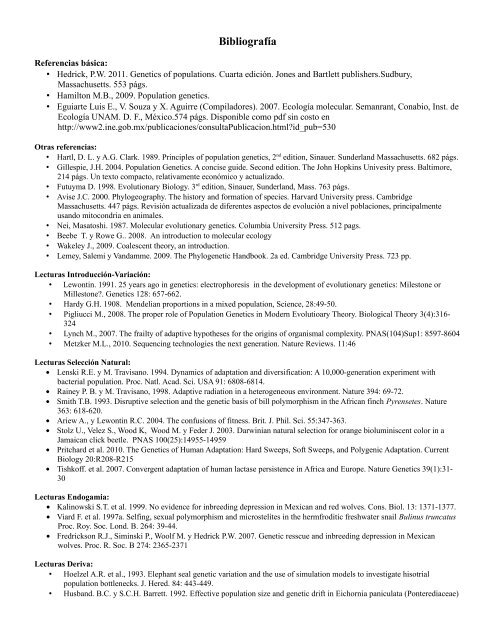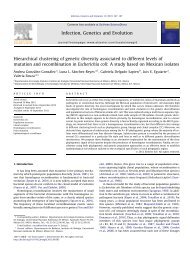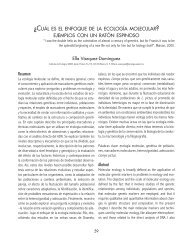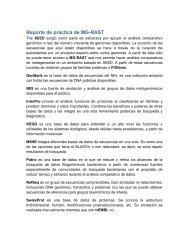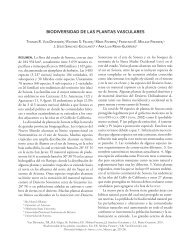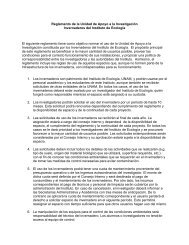Temario - UNAM
Temario - UNAM
Temario - UNAM
You also want an ePaper? Increase the reach of your titles
YUMPU automatically turns print PDFs into web optimized ePapers that Google loves.
BibliografíaReferencias básica:• Hedrick, P.W. 2011. Genetics of populations. Cuarta edición. Jones and Bartlett publishers.Sudbury,Massachusetts. 553 págs.• Hamilton M.B., 2009. Population genetics.• Eguiarte Luis E., V. Souza y X. Aguirre (Compiladores). 2007. Ecología molecular. Semanrant, Conabio, Inst. deEcología <strong>UNAM</strong>. D. F., México.574 págs. Disponible como pdf sin costo enhttp://www2.ine.gob.mx/publicaciones/consultaPublicacion.html?id_pub=530Otras referencias:• Hartl, D. L. y A.G. Clark. 1989. Principles of population genetics, 2 nd edition, Sinauer. Sunderland Massachusetts. 682 págs.• Gillespie, J.H. 2004. Population Genetics. A concise guide. Second edition. The John Hopkins Univesity press. Baltimore,214 págs. Un texto compacto, relativamente económico y actualizado.• Futuyma D. 1998. Evolutionary Biology. 3 rd edition, Sinauer, Sunderland, Mass. 763 págs.• Avise J.C. 2000. Phylogeography. The history and formation of species. Harvard University press. CambridgeMassachusetts. 447 págs. Revisión actualizada de diferentes aspectos de evolución a nivel poblaciones, principalmenteusando mitocondria en animales.• Nei, Masatoshi. 1987. Molecular evolutionary genetics. Columbia University Press. 512 pags.• Beebe T. y Rowe G.. 2008. An introduction to molecular ecology• Wakeley J., 2009. Coalescent theory, an introduction.• Lemey, Salemi y Vandamme. 2009. The Phylogenetic Handbook. 2a ed. Cambridge University Press. 723 pp.Lecturas Introducción-Variación:• Lewontin. 1991. 25 years ago in genetics: electrophoresis in the development of evolutionary genetics: Milestone orMillestone?. Genetics 128: 657-662.• Hardy G.H. 1908. Mendelian proportions in a mixed population, Science, 28:49-50.• Pigliucci M., 2008. The proper role of Population Genetics in Modern Evolutioary Theory. Biological Theory 3(4):316-324• Lynch M., 2007. The frailty of adaptive hypotheses for the origins of organismal complexity. PNAS(104)Sup1: 8597-8604• Metzker M.L., 2010. Sequencing technologies the next generation. Nature Reviews. 11:46Lecturas Selección Natural:• Lenski R.E. y M. Travisano. 1994. Dynamics of adaptation and diversification: A 10,000-generation experiment withbacterial population. Proc. Natl. Acad. Sci. USA 91: 6808-6814.• Rainey P. B. y M. Travisano, 1998. Adaptive radiation in a heterogeneous environment. Nature 394: 69-72.• Smith T.B. 1993. Disruptive selection and the genetic basis of bill polymorphism in the African finch Pyrensetes. Nature363: 618-620.• Ariew A., y Lewontin R.C. 2004. The confusions of fitness. Brit. J. Phil. Sci. 55:347-363.• Stolz U., Velez S., Wood K, Wood M. y Feder J. 2003. Darwinian natural selection for orange bioluminiscent color in aJamaican click beetle. PNAS 100(25):14955-14959• Pritchard et al. 2010. The Genetics of Human Adaptation: Hard Sweeps, Soft Sweeps, and Polygenic Adaptation. CurrentBiology 20:R208-R215• Tishkoff. et al. 2007. Convergent adaptation of human lactase persistence in Africa and Europe. Nature Genetics 39(1):31-30Lecturas Endogamia:• Kalinowski S.T. et al. 1999. No evidence for inbreeding depression in Mexican and red wolves. Cons. Biol. 13: 1371-1377.• Viard F. et al. 1997a. Selfing, sexual polymorphism and microstelites in the hermfroditic freshwater snail Bulinus truncatusProc. Roy. Soc. Lond. B. 264: 39-44.• Fredrickson R.J., Siminski P., Woolf M. y Hedrick P.W. 2007. Genetic resscue and inbreeding depression in Mexicanwolves. Proc. R. Soc. B 274: 2365-2371Lecturas Deriva:• Hoelzel A.R. et al., 1993. Elephant seal genetic variation and the use of simulation models to investigate hisotrialpopulation bottlenecks. J. Hered. 84: 443-449.• Husband. B.C. y S.C.H. Barrett. 1992. Effective population size and genetic drift in Eichornia paniculata (Ponterediaceae)


